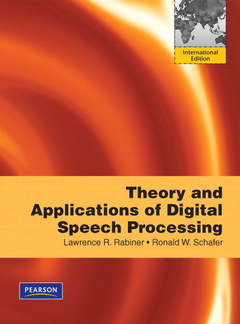Theory and applications of digital speech processing
Auteurs : RABINER Lawrence, SCHAFER Ronald

Theory and Applications of Digital Speech Processing is ideal for graduate students in digital signal processing, and undergraduate students in Electrical and Computer Engineering. With its clear, up-to-date, hands-on coverage of digital speech processing, this text is also suitable for practicing engineers in speech processing.
This new text presents the basic concepts and theories of speech processing with clarity and currency, while providing hands-on computer-based laboratory experiences for students. The material is organized in a manner that builds a strong foundation of basics first, and then concentrates on a range of signal processing methods for representing and processing the speech signal.
CHAPTER 1 Introduction to Digital Speech Processing 1
1.1 The Speech Signal 3
1.2 The Speech Stack 8
1.3 Applications of Digital Speech Processing 10
1.4 Comment on the References 15
1.5 Summary 17
CHAPTER 2 Review of Fundamentals of Digital Signal Processing 18
2.1 Introduction 18
2.2 Discrete-Time Signals and Systems 18
2.3 Transform Representation of Signals and Systems 22
2.4 Fundamentals of Digital Filters 33
2.5 Sampling 44
2.6 Summary 56
Problems 56
CHAPTER 3 Fundamentals of Human Speech Production 67
3.1 Introduction 67
3.2 The Process of Speech Production 68
3.3 Short-Time Fourier Representation of Speech 81
3.4 Acoustic Phonetics 86
3.5 Distinctive Features of the Phonemes of American English 108
3.6 Summary 110
Problems 110
CHAPTER 4 Hearing, Auditory Models, and Speech Perception 124
4.1 Introduction 124
4.2 The Speech Chain 125
4.3 Anatomy and Function of the Ear 127
4.4 The Perception of Sound 133
4.5 Auditory Models 150
4.6 Human Speech Perception Experiments 158
4.7 Measurement of Speech Quality and Intelligibility 162
4.8 Summary 166
Problems 167
CHAPTER 5 Sound Propagation in the Human Vocal Tract 170
5.1 The Acoustic Theory of Speech Production 170
5.2 Lossless Tube Models 200
5.3 Digital Models for Sampled Speech Signals 219
5.4 Summary 228
Problems 228
CHAPTER 6 Time-Domain Methods for Speech Processing 239
6.1 Introduction 239
6.2 Short-Time Analysis of Speech 242
6.3 Short-Time Energy and Short-Time Magnitude 248
6.4 Short-Time Zero-Crossing Rate 257
6.5 The Short-Time Autocorrelation Function 265
6.6 The Modified Short-Time Autocorrelation Function 273
6.7 The Short-Time Average Magnitude Difference Function 275
6.8 Summary 277
Problems 278
CHAPTER 7 Frequency-Domain Representations 287
7.1 Introduction 287
7.2 Discrete-Time Fourier Analysis 289
7.3 Short-Time Fourier Analysis 292
7.4 Spectrographic Displays 312
7.5 Overlap Addition Method of Synthesis 319
7.6 Filter Bank Summation Method of Synthesis 331
7.7 Time-Decimated Filter Banks 340
7.8 Two-Channel Filter Banks 348
7.9 Implementation of the FBS Method Using the FFT 358
7.10 OLA Revisited 365
7.11 Modifications of the STFT 367
7.12 Summary 379
Problems 380
CHAPTER 8 The Cepstrum and Homomorphic Speech Processing 399
8.1 Introduction 399
8.2 Homomorphic Systems for Convolution 401
8.3 Homomorphic Analysis of the Speech Model 417
8.4 Computing the Short-Time Cepstrum and Complex Cepstrum
of Speech 429
8.5 Homomorphic Filtering of Natural Speech 440
8.6 Cepstrum Analysis of All-Pole Models 456
8.7 Cepstrum Distance Measures 459
8.8 Summary 466
Problems 466
CHAPTER 9 Linear Predictive Analysis of Speech Signals 473
9.1 Introduction 473
9.2 Basic Principles of Linear Predictive Analysis 474
9.3 Computation of the Gain for the Model 486
9.4 Frequency Domain Interpretations of Linear Predictive
Analysis 490
9.5 Solution of the LPC Equations 505
9.6 The Prediction Error Signal 527
9.7 Some Properties of the LPC Polynomial A(z) 538
9.8 Relation of Linear Predictive Analysis to Lossless Tube Models 546
9.9 Alternative Representations of the LP Parameters 551
9.10 Summary 560
Pr
Date de parution : 03-2010
Ouvrage de 1056 p.
17.8x23.2 cm
Disponible chez l'éditeur (délai d'approvisionnement : 12 jours).
Prix indicatif 67,30 €
Ajouter au panier


